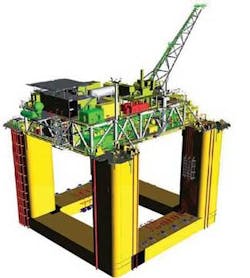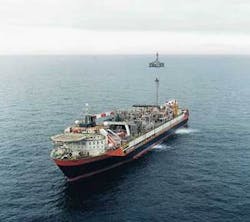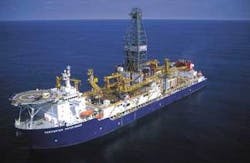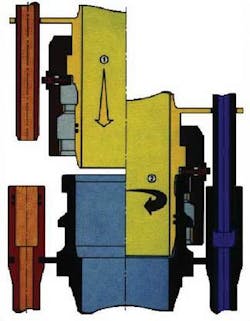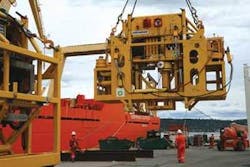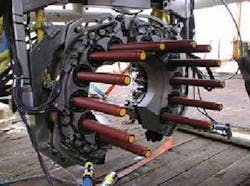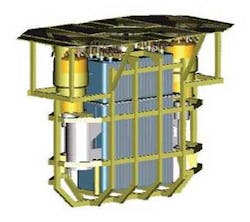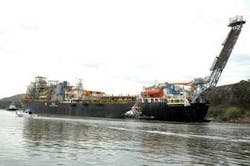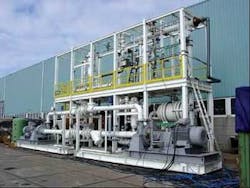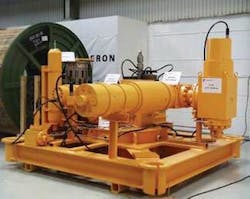Technologies showcased at PennWell’s DOT often move quickly to field
Jay Schempf, Special Correspondent
From new floating mobile drilling and production equipment to subsea production trees and pipelines, and from sea bottom separation systems to infrastructure for deepwater heavy oil development, the list of technology advancements that have debuted at successive Deep Offshore Technology (DOT) conferences is long and diverse.
While some of what were advanced technologies at DOT during the 1980s now are off-the-shelf, conventional equipment, or mature services, many of the tools and techniques introduced at later DOTs - during the 1990s and into the current century - only recently have been transformed into applied deepwater technology. All along the way, some of the technology introduced has been revolutionary in its effects on deepwater operations.
Because of the magnitude of technical advancements announced during the 26 DOT conferences, the number of new technology presentations is too high to include a mention of every one in a story that appraises the overall contributions of DOT. Therefore, theOffshore magazine editorial staff has chosen a representative number of them to serve as examples of design innovations turned into field applications within various aspects of deepwater development. The papers were chosen subjectively, so some new technologies are not included in this wrap-up or in the related “Inevitable” technology story in this section.
Therefore, the following are based on technical presentations made for DOT audiences either exclusively or as enhanced follow-ups on new equipment already introduced to the industry. Some years are omitted, due mainly to a preponderance of papers whose intent was to address a number of industry-wide issues and challenges:
DOT 1995, RIO DE JANEIRO
Deepwater floating production concept - At a session on floating production structures, the concept for a deep-draft floater was introduced (“Development of Deep Draft Floater for Very Deep Waters” by Alf Engseth, J.M. Johnsen, both of Kværner Engineering (now Aker Kværner), A.A. Paulsen of Statoil, and Roy Roberts of BP Exploration).
In their presentation, the authors detailed the growing need for dry tree structures in deepwater and ultra deepwater. This would be true particularly for fields with large workover requirements and the need to store oil in the pontoons and columns of the floating platform itself.
Kværner’s deep draft floater (DDF) - essentially a semisubmersible with very deep columns - was presented as moored with a traditional steel catenary system whose lack of motion allows the use of rigid risers and dry wellheads. The paper presented DDF design considerations for North Sea conditions at two water depths, 2,625 ft (800 m) and 4,265 ft (1,300 m), as well as for two oil storage capacity volumes (storage “free of charge” and five to six days of production), and two production rates (100,000 b/d and 220,000 b/d).
The paper determined that the DDF was a feasible solution for deepwater applications, particularly since the concept was based on traditional technology and required no major advancements in technology.
It was not until late 2005 that Chevron and then partner Kerr-McGee (now Anadarko) elected to award a $120-million contract to Aker Kværner to use a DDF platform as the principal production and storage facility for the Blind Faith field in about 7,000 ft (2,100 m) of water in Mississippi Canyon blocks 695 and 696, about 160 mi (257 km) southeast of New Orleans. Initial handling capacity would be 45,000 b/d of oil and 45 mmcf/d of gas. Production is expected to begin during the first half of 2008. The field has an estimated gross resource potential that exceeds 100 MMboe.
Short-term PSO vessel debuted - Also at the 1995 floating production session, Statoil engineers introduced a tanker-based deepwater production, storage, and offloading facility for use in producing marginal fields in the northern North Sea, particularly in Statoil’s Norne field in Norwegian waters. The vessel was designed to fulfill similar requirements elsewhere around the world, including fields in deeper water.
Aker Kværner’sNorne production ship, as it was later called, was installed in 1997 in 1,247 ft (380 m) of water. It was based on the Tentech 850 S design, which is a ship-shaped vessel with an overall length of 853 ft (260 m), width of 135 ft (41 m), and draft of 82 ft (25 m). It is connected to five subsea templates - three for production, one for water injection, and one for combined gas and water injection. Each template has four slots and the capacity to tie in additional satellite wells.
The vessel weathervanes around a turret attached to the seabed by a 12-point mooring system aided by five fully azimuthing, variable-speed electric thrusters for mooring and position control as well as for main propulsion. Processing facilities and power units are located on deck, while oil is stored in tanks in the hull prior to transfer into shuttle tankers through an offloading system located aft.
Since it was installed at Norne, the production ship has been modified to inject water into and accept production from two additional satellite wells.
Aker Kværner’s Tentech 850 design can be upgraded for deeper water depths. The planned lifetime for the hull structure was 25 years, with systems for material protection defined accordingly. This implies that the vessel could remain on location for a quarter-century without drydocking.
DOT 2000, NEW ORLEANS
Deepwater Pathfinder class drillship - In general, deepwater mobile drilling units today remain in the form of either semisubmersible or ship-shaped floating units whose water depth and drilling depth capabilities can be increased by additions of or enhancements to existing equipment.
At DOT 2000 a team of engineers with R&B Falcon Corp. (now Transocean Inc.) joined with a technical expert from Conoco Inc. (now ConocoPhillips) to discuss building and commissioning theDeepwater Pathfinder drillship (“A Discussion of the Deepwater Pathfinder Construction and Start Up Process and the Lessons Learned from a Major Equipment Failure,” by Tim L. Juran, W. L. (Bill) Ellis, Russell L. Krohn, Daniel L. Farr, and Scott H. Hoelscher, all of R&B Falcon Corp., and Brett M. Borland, Conoco Inc.).
Delivered to R&B Falcon in January 1999, theDeepwater Pathfinder was the first new construction drillship in more than 20 years, and was the first tanker-based drillship in operation. Designed to drill in 10,000 ft (3,048 m) water depth, the rig was originally equipped with 7,500 ft (2,287 m) of riser.
R&B Falcon and Conoco initially owned the rig jointly. Its specifications were determined in mid-1996 to meet the objectives of Conoco’s deepwater exploration program specifically in the Gulf of Mexico.
Overall, the authors noted, construction and startup was successful, with delivery on time and budget. The drillship worked for a full year without a lost-time accident. However, a subsequent drawworks failure resulted in a dropped BOP and riser. Since no lost-time injuries resulted, the authors pointed out, a silver lining to such a failure was contained in lessons learned about integrating new, unproven equipment into a complex operating system and minimizing the new risks associated with such integrated systems.
These and other lessons learned were reflected in the ultimate addition by the new owner, Transocean, of 12 fifth-generation deepwater floaters like theDeepwater Pathfinder, most of them with an operating water depth capability of 10,000 ft (3,048 m) - all built since 1998.
“Clip” Riser technology - Also at DOT 2000, Technical specialists from the Institut Francais du Petrole (IFP) and marine drilling contractor Pride International discussed updated technical information on a 21-in. (533-mm) OD deepwater riser system under development by IFP since the 1980s for use in water depths to 10,000 ft (3,048 m) (“Riser Technology for Ultra Deepwater Drilling,” by C. Gaillard, J. Guesnon, C. Sparks, all of IFP, and Y. Kerbart of Pride International).
The new riser system’s architecture, the authors noted, would depend mainly on factors related to operational and environmental conditions such as water depth, mud weight, inside diameter and working pressures for both riser and auxiliary lines, current profile, and storm conditions.
Called the “Clip” Riser, it was designed to:
- Allow fast and safe connection of riser joints with high load capacity equipped with large-diameter/high pressure choke and kill lines
- Use lightweight hybrid steel/composite choke and kill lines to lower overall riser mass and weight on deck and improve axial dynamic behavior in the hung-off mode
- Use hyperstatic auxiliary lines designed to participate in the axial strength of the riser, allowing reduction in the riser section, reduced fatigued stresses and decreased resonant periods in deepwater.
At the time, the Clip Riser was being manufactured and marketed under license by Kværner Oilfield Products (now Aker Kværner), Houston. Two of the risers were in service on the drillshipsPride Africa and Pride Angola.
As recently as October 2006, however, Aker Kværner had signed an $80-million contract with a Brazilian offshore drilling contractor to supply Clip Risers in 2007 for three drilling rigs, two of which will work in Brazilian deepwater operations conducted by national oil company Petrobras. The third system also will work for Petrobras, but will be applied both in Brazil and internationally.
Subsea multiphase pumps - For the DOT 2000 session on subsea equipment, Kværner Oilfield Products (Aker Kværner) introduced a prototype deepwater pumping system currently under tests in Norway (“The Kværner Multiphase Pump System for Deepwater Applications,” by O.F. Jahnsen, John Yardley, Geoff High, and Brede Thorkilsen, all of Kværner Oilfield Products A/S.).
The authors noted that with offshore activity continuously pushing technology into deeper water, more emphasis was being placed on developing improved technologies that also were cost-effective. One such technology was subsea boosting. In recent years, Kværner had made significant efforts to develop and qualify energy enhancement solutions for low-energy reservoirs and for deepwater and extended tie-backs to accelerate and enhance production and to give higher net present value to developed reserves.
One solution the authors suggested was Kværner’s subsea multiphase pump (MPP) system, under development with German pump manufacturer Bornemann.
The MPP and motor are packaged into modular components readily adaptable to template and manifold configurations for maximum use of existing qualified components and subsystems. A guidewireless system ensures self-alignment when installed at simple flow base interfaces, making the pump ideal for deepwater applications. Due to the pump’s light (40-metric-ton [44-ton]) weight and the narrow moon pool dimensions of both flow base and pump module, both installation and retrieval could be accomplished with light mono-hull vessels.
The MPP is equipped with a Bornemann twin-screw pump modified for use in water depths of up to 6,560 ft (2,000 m) and driven by a lightweight, oil-filled electric motor. Pump features include flexible operation covering all gas-liquid ratios, together with tolerance for slug flow and some sand. In particular, the authors noted, compared with centrifugal pump designs, the twin-screw, positive displacement MPP design can maintain the pressure boost specification independent of gas content at the pump inlet, and without an upstream mixing tank.
According to the authors, Kværner’s modular approach offered flexible solutions by using compact, lightweight building blocks incorporating proven subsea technology in order to be used in new field development or to retrofit existing facilities. The objective, they said, was to have a fully qualified and integrated subsea system in the field by 2Q 2001.
The first of the Kværner MultiBooster pumps, as the system came to be named, was not installed until January 2006, when operator Canadian Natural Resources installed a system in the marginal Lyell field in the UK North Sea. Three more systems were scheduled for installation in July 2007 at BP’s King field in the Gulf of Mexico, which is slated to begin production later this year. The installation will break world records when the MultiBooster systems are installed for application in water depths in excess of 5,575 ft (1,700 m), more than 18 mi (29 km) from the field’s main platform.
Deepwater pipe, flowline repair - DOT 2000’s session on pipelines featured a presentation covering a deepwater pipeline repair system (“The Repair of Pipelines and Flow Lines in Deep and Ultra DeepWater,” by J.Frazer and J. Giles, both of Stolt Offshore (now Acergy), and D. Gibson of the National Hyperbaric Centre in the UK).
Deepwater pipeline beyond the depth limits of diver intervention requires a different approach to repair contingency planning, presupposing a greater level of readiness. Additionally, deepwater pipeline repair procedures tended to be based on remotely activated mechanical connectors, one set available for each pipeline inside diameter. Also, such connectors tend to be complex, expensive, and require a significant up-front investment for repair equipment that might never be used.
For those and other reasons, Norway’s national oil company, Statoil, adopted repair techniques and equipment to tie in new pipelines. Conversely, offshore contractors such as Stolt Offshore developed pipeline tie-in equipment that can be used in repair situations. Basing this equipment on the use of low-cost, readily available standard flange connectors, Stolt christened this equipment the “modular advanced tie-in system (Matis).”
Essential to the Matis system is friction stitch welding, a solid phase welding process that can be adapted for deepwater pipeline construction and repair.
The original Matis development, which was part of the Joule-Thermie program sponsored by the European Commission, was tested during a series of offshore trials in 320 ft (100 m) of water in 1997. A significant development program followed to further enhance the capabilities of the system and to produce several operational units. In 2000, Matis could operate with flanges within the range of 8-24 in. (20-61 cm) to a maximum water depth of 9,850 ft (3,000 m). The flange size range could be increased with simple modifications.
Matis was first used commercially beginning in 1999 to connect a 9-in. (229-mm) flange on the North Sea Loke field for Statoil. Statoil also began using the system in the second half of 2000 for five flange tie-ins ranging from 22-24 in. (56-61 cm), in 720 ft (220 m) of water in the Gulfaks field.
Beginning in 2001, two Matis systems were used extensively in subsea tie-in work on the Girassol development offshore Angola. Just short of 100 flange connections, ranging from 9-13 in. (23-33 cm) D, were made in about 4,430 ft (1,350 m) of water. The work at Girassol included a significant number of vertical flange connections for the tie-in of the riser towers to the flowlines. Stolt was able to complete the underwater tie-ins of both 9-in. (229 mm) and 13-5/8-in. (346 mm) pipe in an average time of eight hours, with a record tie-in time of four hours.
First oil at Girassol started to flow in December 2001, and according to operator Total, the field has been running free of flow-assurance problems ever since.
DOT 2001, RIO DE JANEIRO
Atlantis artificial buoyant seabed - At DOT 2001, held in Rio de Janeiro, Brazil, a representative of Norwegian company Atlantis Deepwater Technology Holding A/S discussed the artificial buoyant seabed (ABS) feature of the company’s patented Atlantis Deepwater Concept, a three-pronged system for exploratory drilling, field development, and production (“The Atlantis Deepwater Concept - Also a Way to Obtain Improved Reach of Deepwater Wells,” by Pål Norheim, managing director of Atlantis Deepwater Technology Holding AS).
According to Norheim, the deepwater concept’s ABS component is installed at a shallow depth, typically 655-985 ft (200-300 m), yet replaces the functions of the real seabed much farther below. No equipment other than flowlines remains on the real seabed. A tieback of the first well casing, the 20-in. (51-cm) surface casing, is used to anchor the new ABS “seabed.” Finally, said Norheim, the Atlantis system is a wellbore concept and should not be mistaken for a type of freestanding riser, though it may look similar.
With Atlantis’ system, the wellhead and BOP, and in the case of production, a subsea tree, are placed on the ABS, which provides enough buoyancy and tension in the casing to keep the well in a near-vertical position in the water column.
The Atlantis concept could be used as a composition of different building blocks in order to fit the needs of any deepwater field, said Norheim. Being a well concept, it can be used as a single well version for exploration drilling or as a multi-well version for field development and production.
However, the chief benefit is that all aspects of deepwater operations will be limited to less than 1,000 ft (305 m) of water, regardless of sea-bottom depth. This would allow operators to use less expensive second- and third-generation rigs for exploratory drilling, and in the production mode would allow for an unlimited number of wells for production, with cost affected only marginally affected by the size of the ABS and the spacing between wells. Completion, re-drilling, and workover time also are reduced, with the cost at nearly the same level as working in shallow water.
In April 2002, Statoil bought a 12% interest in Atlantis. This was significant in that by August, Statoil and several other producing companies had joined with Atlantis to test a deepwater concept with ABS in protected waters of the Gands Fjord near Stavanger off western Norway.
By April 2005, first use of the ABS prototype unit for deepwater drilling was set for deepwater drilling in Chinese waters as well as in southeast Asia and off Australia. The deal was with China Oilfield Services Ltd. (COSL), whose main shareholder is the China National Offshore Oil Corp. (CNOOC).
The ABS unit was to be deployed from COSL’sNanhai 5 semisubmersible and was scheduled to be used in drilling an exploration well in 650 ft (195 m) of water. This would be followed by additional wells in far deeper water depths of 4,900 ft to 6,500 ft (1,500 m to 2,000 m). Since that time, drilling for COSL has remained “tight”.
Power for subsea “consumers” - At the first of three subsea sessions at DOT 2001, an update on field testing of a cost-effective subsea power system gave a bit more body to the elusive goal of practical subsea production processing or boosting technology (“Sepdis - Powers the Deepwater Development,” by N.A. Soelvik and Svend Rocke, both of ABB Offshore Systems A/S).
A result of efforts by several major operating companies, including Statoil, Norsk Hydro, Shell, ExxonMobil, and BP, was the subsea electrical power distribution system (Sepdis). This technology, the authors said, would drive any subsea rotating machinery and provide reliable power supply to control systems, electrical heating of pipelines, and subsea processing equipment. Development of the Sepdis system also was driven and partially funded by Norwegian contractor Framo Engineering A/S. Advances in development were achieved as well from inclusion of the technology in the Norwegian government/industry Demo 2000 JIP.
According to the authors, Sepdis is ideal for tailor-making electrical transmission, distribution, and control solutions for specific applications. The achievable step-out distance with the system would depend on the electrical power requirement at the remote location. A 36-kv transmission voltage would enable 100-km (62-mi) step-out distances and beyond, depending on the end load level, the authors said.
Sepdis equipment was designed to be installed topside on the host facility. It was limited to a circuit breaker for fault protection and a standard step-up transformer for transformation to transmission voltage to provide galvanic isolation between the subsea and topside system. All the electrical power required subsea is transmitted over a single power cable to a subsea transformer, which makes the interface between the transmission and local distribution system. A high-voltage, wet mate-able connector between the subsea transformer and the power cable was developed, qualified, and tested to allow all of the subsea modules to be installed and retrieved separately.
The distribution system, an integral part of the subsea transformer module, featured a selection of distribution voltage levels (3.3-12 kv line voltage), depending on load and distance to the load control modules. These modules could be anything from a single connection jumped directly to the load via a circuit breaker or fixed speed motor starter, to a state-of-the-art variable speed drive system. The subsea frequency converter features speed and torque control for megawatt pumps in any form. The converter module is a semi-self-contained system with an integrated circuit breaker for fault protection, a dedicated three-winding input transformer, the frequency converter itself, an output sinus filter, and a remote control system interface. Jumper cables from the subsea converter module to the load complete the whole subsea electrical supply system.
The first Sepdis system was installed in late 1999 on Norsk Hydro’s Troll C oil and gas field in the Norwegian sector of the North Sea in 1,150 ft (345 m) of water, but the subsea wells were not brought onstream until August 2001. Initially, the Sepdis ran for about 4,500 hours before it had to be retrieved for re-fit. Once the situation was corrected, the system was reinstalled with plans to run it for an additional 6,000 hours. Meanwhile, ABB Offshore attempted to interest one of the operators in the JIP in testing the system in much deeper water.
In August 2002, Statoil began investigating the use of several new subsea technologies on satellite wells connected to its Norne field production facility. One of these subsea technologies was a collection of subsea separation systems from three equipment suppliers with whom Statoil had framework agreements. One, to be supplied by ABB Offshore, included a Sepdis system.
The Troll pilot program acted as a proving ground for subsea production and processing equipment designed for ultra deepwater, with the awareness both by Hydro and by equipment manufacturers that lessons learned at Troll would result in changes made to prototype systems. The ABB Offshore/Framo Sepdis system continues to undergo modifications so as to be included as a component of future iterations of subsea processing and separation systems.
DOT 2004, NEW ORLEANS
Heavy oil exploitation off Brazil - Two technical presentations dealing with development of deepwater heavy oil deposits were presented by engineers with Petrobras, Brazil’s national oil company. One paper listed the challenges involved (“Heavy Oils and Deep Waters: A Challenge for Petrobras,” by G.C. Nunes, C.A.C. Moraes, J.V.B. da Silva Ramalho, and M.W. de Figueiredo). The other paper covered specific development plans for an offshore heavy oil field discovered off Brazil (“Jubarte Field Development Architecture,” by C.A.G. Pereira, J.F. Nicodemos, R.S. da Costa, R.A.B. Vieira, and Roberto de Oliveira Goulart, all of Petrobras, and I.A. Pinto, a consultant).
The authors addressed the challenges resulting from discovery of significant amounts of ultra deepwater (4,920 ft or 1,500 m) heavy oil (about 14-19° API; average viscosity at the surface: 500 cP), and extra-heavy oil (14° API or lower, with average viscosity at the surface of 10,000 cP) in Brazilian waters. They also noted that Petrobras had begun to take part in developing and qualifying new heavy oil extraction and processing technologies proposed by major equipment manufacturers, with research groups being formed and JIPs joined.
The authors also noted that at that time, heavy and extra-heavy oil discoveries off Brazil had translated into 6-7 Bbbl of reserves. Additionally, they pointed out, the deepwater Atlantic off West Africa and the western Gulf of Mexico also hold substantial heavy oil reserves, many for which had not been explored. The many technology gaps connected to offshore heavy oil exploitation - such as subsea separation systems for heavy oils -would delay development, they added.
High viscosities, low API gravity, and high-temperature heating and treating requirements, with deepwater, combine to reduce the commercial attractiveness of heavy oils, they observed, particularly since traditional offshore production system costs are extremely high, even for light oils. The question of how to handle and reinject growing volumes of produced water from mature offshore fields also posed a significant problem, they said.
Petrobras had started R&D programs aimed at what the company considered the most significant de-bottlenecking technologies for oil and water treatment systems. Significant testing was being planned for two sites under construction at the time, one of them offshore. Field tests had begun with hydrocyclones, with plans to test coalescers by 2005. A subsea processing project, then under way offshore, was expected to be completed by 2006, the authors said. Overall results at the time the paper was presented implied that reaching the objectives of the heavy oil processing and water treatment projects was feasible.
Meanwhile, the other Petrobras group discussed development plans for the Jubarte field, a heavy oil discovery off southeastern Brazil in water depths between 3,280 and 4,920 ft (1,000-1,500 m). Discovered in Jan. 2001, the field lies about 48 mi (77 km) off the Espírito Santo state coast, in block BC-60. The field contains oil with an average API gravity of 17.1°.
According to the authors, the dead oil viscosity at 20° C is about 3,000 cP, making it the most viscous oil at surface conditions ever produced in Brazil through a wet completion system.
At the time of the paper, Jubarte was undergoing extended well testing. Meanwhile, an early production system (EPS) FPSOP-34, was being converted to handle Phase 1 production in the field while several versions of a definitive production system (DPS) in the form of a stationary production unit were under consideration for Phase 2.
The Jubarte field, like most of Petrobras’ offshore discoveries, was to be considered a “laboratory” for acquiring knowledge to develop heavy oil reservoirs in deep waters. And the knowledge acquisition continues today.
At the 2007 Offshore Technology Conference in Houston in May 2007, Christina Pinho, Petrobras’ general manager for E&P installation, production, and inspection, said the innovations being developed by Petrobras in the Espírito Santo basin are aimed at heavy oil processing. TheP-34 FPSO remains at Jubarte, she said, and it operates as a laboratory on the high seas, helping the company find solutions to both flow and processing challenges.
Pinho noted that no other company in the world currently explores for and produces heavy oil in deepwater. She added that Petrobras has formed partnerships with several technology developers to tackle the challenges posed by deepwater offshore heavy oil production.
Petrobras continues to explore for and develop heavy oil in Espírito Santo as well as in the Campos basins, where older fields still contain billions of barrels of heavy oil in place, much of it offshore, Pinho said.
Subsea separation challenges - As a part of the first of three subsea technology sessions at DOT 2004, presenters discussed the topic of developing subsea technologies to help increase recovery at a lower cost in detail (“Deepwater Subsea Separation: Technical Challenges and Solutions,” by Rune Fantoft at FMC Kongsberg Subsea A/S and Toine Hendriks of CDS Engineering B/V, an FMC subsidiary).
The authors set the stage with their observation that by 2004, the offshore industry was showing increased interest in subsea processing as a field development element with great potential to improve field economics. Subsea separation had emerged as such a near-future tool as well, they said, and should meet strict requirements to achieve highly efficient separation performance throughout the useful life of the system. The combination of separation and handling associated solids was particularly important.
Generally speaking, they said, subsea processing could be defined as any active handling and treatment of produced fluids at or below the seabed, with the main focus on:
- Multiphase boosting/pumping
- Separation processes
- Wet gas boosting/compression.
Benefits available by introducing such subsea processing into field development would include:
- Reducing capex
- Accelerating production and recovery
- Allowing development of marginal or remote fields in ultra deepwater
- Extending production from existing fields
- Enabling tie-ins of satellite developments into existing infrastructure by removing fluid-handling restraints
- Improving flow management by using subsea water separation as a hydrate prevention strategy
- Reducing the impact on the deepwater environment.
According to the authors, one particular element of subsea processing - water separation followed by water reinjection into the reservoir - was seen as a tool for improving field economics. Initially, high added cost calculated for technical risk, some missing qualified components, and general conservativism in the industry held this market back. However, since the cost-savings potential was tempting, and as R&D reduced the technical uncertainties, the subsea processing option became more and more interesting to operators.
FMC Kongsberg Subsea (now FMC Technologies) and CDS Engineering’s compact gravity based separation concept with integrated solids handling had been qualified through an extensive test program, the authors said. As a result, subsea water separation was considered available for near-term installation. Additionally, they said, separation technologies, including emerging ultra compact inline separation, should be particularly suited for deepwater subsea applications.
Almost a year later, in November 2005, FMC Technologies announced it had signed a $100-million contract with Statoil to provide a subsea separation boosting and injection system for the Tordis field in the Norwegian sector of the North Sea.
The contract for the subsea separation/boosting system included a retrievable separation module, a desander system, multiphase and water injection pumps, and a water injection tree. Umbilicals and related equipment were included along with the control systems and topside equipment, the company said.
The Tordis subsea separation system was installed between the existing Tordis subsea field and the Gullfaks C platform, increasing the recovery factor from 49% to 55%. FMC officials said Statoil engineers calculated that production from Tordis would increase by about 35 MMbbl of oil over the life of the field as a result of using the FMC/CDS system.
DOT 2005, VITORIA, BRAZIL
Electric subsea production: positive charge, clean solution - A subsea production system developed by Cameron was covered in technical presentations in DOT 2004 and 2005. The two papers were:
- “An All-Electric Subsea Production System; A Positive Charge,” by Robert Lopez of Cameron
- “The All-Electric Subsea Production System - The Clean Solution,” by Robert Lopez and John Burdick, both of Cameron.
In both presentations, the authors noted that the trend toward longer tieback distances for deepwater subsea production has pushed or exceeded the limits of conventional electro-hydraulically (EH) controlled subsea systems. Deficiencies in the areas of system and component reliability, actuation response time, hydrostatic effects (particularly in ultra deepwater), and environmental issues related to use of hydraulic fluid, the authors observed, have prompted the industry to seek improvements or alternatives.
Instead, the Electric Subsea Systems group of Cameron’s Subsea Division developed an all-electric controls technology for subsea production systems, with particular emphasis on overcoming the abovementioned deficiencies and on the benefits accruing to operators. Therefore, a rather straightforward all-electric system prototype was built and a substantiation program initiated to consider several key aspects, including technology development, commercial justification (using reliability and value assessment tools), and system validation involving field trials.
By 2004, Cameron had conducted “shakedown” trials in 50 ft (15 m) of water in the fjord adjacent to its Stavanger, Norway, facility and later enlisted the cooperation of BP’s E&P Technology Group in conducting field trails of the all-electric system at the Magnus field platform in the UK North Sea. The trials were designed to simulate a 20-year operational life based on the total number of actuation cycles. By the time Lopez delivered his 2004 technical paper in December 2004, the Magnus field trial had reached six months in length, with 250 valve actuation cycles among the tests already performed.
At DOT 2005, Lopez and Burdick noted that while high-pressure hydraulics provide the forces necessary to actuate subsea production controls, it becomes problematic as step-out distances increase. For long step-outs, the use of hydraulics requires large, complex, expensive umbilicals containing high and low pressure hydraulic tubing, power conductors, communications lines, and often chemical injection lines.
In contrast, they noted, using an all-electric alternative, particularly one using direct current (DC) power, reduces the umbilical to a simple coaxial cable for combined power and communication. In addition to transmitting power and communications transmission over great distances in a relatively small conductor, the all-electric system is lower in cost compared to EH umbilicals, the authors said. Also, vessel costs to install smaller, less complex cable also can be reduced.
The HSE benefits of the all-electric system are obvious, given the elimination of slippery and potentially toxic hydraulic fluids, not to mention the exclusion of the high-pressure accumulators and hoses involved in EH actuation.
Coaxial cable umbilicals are smaller, lighter, less complex, easier to manufacture, and more economical than systems using EH umbilicals. The ability to include fiber optics in the cable eliminates the need for repeaters, and the cable is easy to locate, raise, and splice in the event that deepwater intervention is required, the authors said.
Finally, umbilical cost becomes a major factor as tie-back distances increase. According to the authors, depending upon field configuration, an all-electric umbilical at that time cost between 40% and 60% of the material cost of a corresponding EH umbilical. Cost savings associated with eliminating EH support equipment and the overall effects of EH on health, safety, and environmental issues combine to make the case strong for all-electric subsea production systems, particularly for deepwater and ultra deepwater operations.
In September 2006, French company Total awarded Cameron a contract for a CameronDC all-electric subsea production system for use in the two-well K5F development in the Dutch sector of the North Sea.
The workscope included supply by Cameron of all-electric subsea trees and an all-electric control system, with the capability to expand the system to four wells. Deployment to the field is planned for mid-2007, with production set to begin later in the year.
According to Cameron, Total conducted extensive technical and economic reviews of the system prior to signing the contract. The objective was to verify the system’s advantages and benefits over EH technologies, including increased production system availability, improved operational functionality, and enhanced environmental performance.
Additionally, in Nov. 2006, Cameron announced it had entered into a 10-year frame agreement with BP to provide subsea systems and related services for BP’s deepwater production business unit’s subsea tie-back program, as well as for future subsea developments managed by BP in the Gulf of Mexico. The first order under the new agreement, which covers subsea trees, controls, manifolds, and well connection systems, was expected to be for a multi-well subsea tie-back project.
Though no acknowledgement was made of potential applications of the CameronDC system in any of BP’s deepwater subsea development operations, the frame agreement opens the door to the possibility.
